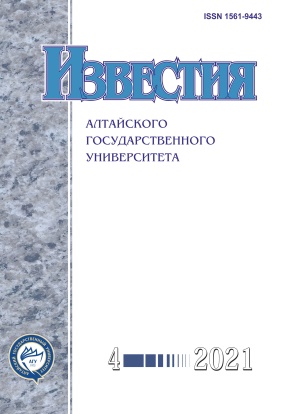Structural Phase States and Surface Properties of Steel 45 after Electroexplosive Borocoppering and Electron-Beam Treatment
УДК 53:669.017
Abstract
The paper concerns improving the microhardness and wear resistance of steel 45 by the combined treatment of electroexplosive borocoppering with the subsequent electron-beam treatment. It is found that surface roughness at the area of the electroexplosive treatment increases along with the absorbed power density and the mass of boron powder. The electron-beam treatment leads to a decrease of roughness and appearance of craters instead of radial melt flow traces. The depth structure of the electroexplosive alloying area with a thickness of 25 µm includes a coating layer, near-surface, intermediate, and boundary layers. The surface microhardness and the depth of the hardening zone after the electroexlosive alloying increase along with the absorbed power density and boron concentration and reach the values of 1400 HV The electron-beam treatment causes merging of the coating and the surface layers and increases the hardening zone depth up to 80 µm. A cellular or dendritic crystallization structure is formed near the surface, and a grain structure is formed in the depth. The inhomogeneous distribution of alloying elements over the volume of the alloying area and its adjustment during the electron-beam treatment are established. The inter-dendritic distances and grain diameters increase as the absorbed power density becomes higher with the increase of the electron-beam treatment exposure time. Also, the size of martensite needles increases in the depth. The combined treatment produces the sub microcrystalline strengthening phases-borides FeB, Fe2B, FeB2, carboboride Fe23 (C, B)6 , and carbide B4C. The microhardness level is reduced to 800 HV, and the wear resistance increases up to five times when compared to the wear resistance of the base.
Downloads
Metrics
References
Белый А.В., Калиниченко А.С. Девойно О.Г. Кукареко В.А. Инженерия поверхностей конструкционных материалов с использованием плазменных и пучковых технологий. Минск, 2017.
Денисова Ю.А., Иванов Ю.Ф., Иванова О.В. и др. Эволюция структуры поверхностного слоя стали, подвергнутого электронно-ионно-плазменным методам обработки / под общ. ред. Н.Н. Коваля и Ю.Ф. Иванова. Томск, 2016.
Углов В.В., Шиманский В.И., Асташинский В.М., Черенда Н.Н. Модификация титана при воздействии компрессионными плазменными потоками. Минск, 2017.
Багаутдинов А.Я., Будовских Е.А., Иванов Ю.Ф., Громов В.Е. Физические основы электровзрывного легирования металлов и сплавов. Новокузнецк, 2007.
Цвиркун О.А., Будовских Е.А., Багаутдинов Я.А., Иванов Ю.Ф., Громов В.Е. Морфологические особенности кристаллизации поверхностных слоев железа и никеля при электровзрывном легировании // Изв. вузов. Черная металлургия. 2007. № 6.
Иванов Ю.Ф., Колубаева Ю.А., Коновалов С.В., Коваль Н.Н., Громов В.Е. Модификация поверхностного слоя стали при электронно-пучковой обработке // Металловедение и терм. обраб. металлов. 2008. № 12.
Зубченко А.С., Колосков М.М., Каширский Ю.В. и др. Марочник сталей и сплавов / под ред. В.Г. Сорокина. М., 2003.
Григорьянц А.Г., Шиганов И.Н., Мисюров А.И. Технические процессы лазерной обработки. М., 2006.
Крукович М.Г., Прусаков Б.А., Сизов И.Г. Пластичность борированных слоев. М., 2010.
Марусин М.В., Щукин В.Г., Марусин В.В. Поверхностное легирование углеродистой стали медью при высокоэнергетической индукционной обработке // Физика и химия обраб. материалов. 2010. № 5.
Марусин М.В., Щукин В.Г., Филимоненко В.Н., Марусин В.В. Борирование стали при индукционной обработке // Физика и химия обраб. материалов. 2003. № 4.
Бурнышев И.Н., Валиахметова О.М., Мутагарова С.А. К вопросу борирования сталей // Вестн. ИжГТУ 2007. № 4.
Баландин Ю.А. Упрочнение поверхности штамповых сталей диффузионным борированием, боромеднением и борохромированием в псевдоожиженном слое // Металловедение и терм. обработка металлов. 2005. № 3.
Copyright (c) 2021 Екатерина Степановна Ващук, Евгений Александрович Будовских, Людмила Петровна Бащенко , Виктор Евгеньевич Громов, Крестина Владимировна Аксенова

This work is licensed under a Creative Commons Attribution 4.0 International License.
Izvestiya of Altai State University is a golden publisher, as we allow self-archiving, but most importantly we are fully transparent about your rights.
Authors may present and discuss their findings ahead of publication: at biological or scientific conferences, on preprint servers, in public databases, and in blogs, wikis, tweets, and other informal communication channels.
Izvestiya of Altai State University allows authors to deposit manuscripts (currently under review or those for intended submission to Izvestiya of Altai State University) in non-commercial, pre-print servers such as ArXiv.
Authors who publish with this journal agree to the following terms:
- Authors retain copyright and grant the journal right of first publication with the work simultaneously licensed under a Creative Commons Attribution License (CC BY 4.0) that allows others to share the work with an acknowledgement of the work's authorship and initial publication in this journal.
- Authors are able to enter into separate, additional contractual arrangements for the non-exclusive distribution of the journal's published version of the work (e.g., post it to an institutional repository or publish it in a book), with an acknowledgement of its initial publication in this journal.
- Authors are permitted and encouraged to post their work online (e.g., in institutional repositories or on their website) prior to and during the submission process, as it can lead to productive exchanges, as well as earlier and greater citation of published work (See The Effect of Open Access).








